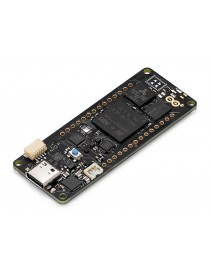

No products in the cart.


The Portenta H7 Lite is a cost-effective solution, designed for complex environments where radio communication is not suitable or possible. It is perfect for developers who want to leverage the computational power of the Portenta H7, without the need for video output or advanced security features.
The Portenta H7 Lite simultaneously runs high-level code and real-time tasks thanks to its two processors. For example, it can execute Arduino-compiled and MicroPython code at the same time, and have the two cores communicate with one another.
Key benefits include:
The Portenta H7 Lite offers twofold functionality: it can run either like any other embedded microcontroller board, or as the main processor of an embedded computer.
For example, use the Portenta Vision Shield to transform your H7 Lite into an industrial camera capable of performing real-time machine learning algorithms on live video feeds. As the H7 Lite can easily run processes created with TensorFlow™ Lite, you could have one of the cores computing a computer vision algorithm on the fly, while the other carries out low-level operations like controlling a motor or acting as a user interface.
Portenta is the go-to family when performance is key, and the H7 Lite is no exception. We can already envision it as part of a wide range of solutions, including:
Two Parallel Cores
The Portenta H7 Lite’s main processor is the STM32H747 dual core including a Cortex® M7 running at 480 MHz and a Cortex® M4 running at 240 MHz. The two cores communicate via a Remote Procedure Call mechanism that allows calling functions on the other processor seamlessly. Both processors share all the in-chip peripherals and can run:
|
Microcontroller |
STM32H747XI dual Cortex®-M7+M4 32bit low power Arm® MCU (datasheet) |
|
Secure Element (default) |
Microchip ATECC608 |
|
Board Power Supply (USB/VIN) |
5V |
|
Supported Battery |
Li-Po Single Cell, 3.7V, 700mAh Minimum (integrated charger) |
|
Circuit Operating Voltage |
3.3V |
|
Current Consumption |
2.95 μA in Standby mode (Backup SRAM OFF, RTC/LSE ON) |
|
Timers |
22x timers and watchdogs |
|
UART |
4x ports (2 with flow control) |
|
Ethernet PHY |
10 / 100 Mbps (through expansion port only) |
|
SD Card |
Interface for SD Card connector (through expansion port only) |
|
Operational Temperature |
-40 °C to +85 °C |
|
MKR Headers |
Use any of the existing industrial MKR shields on it |
|
High-density Connectors |
Two 80 pin connectors will expose all of the board's peripherals to other devices |
|
Camera Interface |
8-bit, up to 80 MHz |
|
ADC |
3× ADCs with 16-bit max. resolution (up to 36 channels, up to 3.6 MSPS) |
|
DAC |
2× 12-bit DAC (1 MHz) |
|
USB-C |
Host / Device, High / Full Speed, Power delivery |